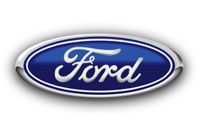Ford Developing Laser Ignition System
Ford and the University of Liverpool are owrking on a new laser ignition system for automobiles.

Ford is teaming up with the University of Liverpool to throw out the old-school spark plugs and design a laser ignition system for internal-combustion engines. According to The Telegraph, a fiber-optic cable--powered by the car's battery--shoots the laser beam to a focusing lens that would consume a much smaller space than current spark plugs. The lenses focus the beams into an intense pinprick of light, and when the fuel is injected into the engine, the laser is fired and produces enough heat to ignite the fuel.
The University researchers claim that the new technology--using lasers to ignite the fuel--is more reliable and efficient than current spark plug technology. Although the laser will need to fire more than 50 times per second to produce 3000 RPM, it will require less power than current spark plugs. The lasers can also reflect back from inside the cylinders to relay information based on fuel type used and the level of ignition, enabling cars to readjust the quantities of air and fuel for optimum performance.
"Lasers can be focused and split into multiple beams to give multiple ignition points, which means it can give a far better chance of ignition," said Dr. Tom Shenton, leader of the project. "This can really improve the performance of the engine when it is cold, as this is the time when around 80 per cent of the exhaust emissions are produced and the engine is at is least efficient. The laser also produces more stable combustion so you need to put less fuel into the cylinder."
Ford said that it plans to implement the new technology into its top of the range vehicles within the next few years, and then make the laser ignition system available for its remaining models sometime thereafter.
Sign up to get the BEST of Tom's Guide direct to your inbox.
Get instant access to breaking news, the hottest reviews, great deals and helpful tips.
Kevin started taking PCs apart in the 90s when Quake was on the way and his PC lacked the required components. Since then, he’s loved all things PC-related and cool gadgets ranging from the New Nintendo 3DS to Android tablets. He is currently a contributor at Digital Trends, writing about everything from computers to how-to content on Windows and Macs to reviews of the latest laptops from HP, Dell, Lenovo, and more.
-
burnley14 This was never what I imagined when I thought of driving a car with lasers in it . . .Reply
It sounds cool, but also sounds like one of those science experiments that will inevitably fail. -
mavroxur This is why US auto makers continue to fail. Instead of looking toward the future and spending money on R&D of alternative energy sources, we're reinventing ways to burn dinosaur juice. Let's take that money and...I dont know....invest it in battery or fuel cell technology research. It's like a company inventing a new and improved way to deliver a better picture on CRT monitors or something....Reply -
thejerk for the person who dinged me a point...Reply
ABS
Navi
3-point seatbelts
HID headlights
ESP
they all debuted in the s-class benz -
Uncle Meat ReplyAlthough the laser will need to fire more than 50 times per second to produce 3000 RPM
On a four-stroke engine, the spark plug fires once every two rotations, not once every rotation. -
P_haze420 no no no. You guys don't understand. Gov shut us, the people up. They want to keep oil prices high and low mileage cars so they can get more money. There's so many good inventions that we don't even know and it would been better for us.Reply
Look at this, 100mpg 80s Mustang. He said that all it needs a one part to the car and it will bring 110 percent in mileage.
See it for yourself.
http://www.youtube.com/watch?v=MsHoZPLPoq4 -
cruiseoveride But honestly, how much power is used by the coil and amplifier that would result in better fuel economy if the lasers were used insteadReply -
alextheblue Interesting, but I think HCCI has more promise. GM and others have working HCCI prototypes, and the gains in efficiency are far more promising. Better yet, couple a small HCCI motor to the Voltec powertrain.Reply -
idahoflyer A multi-cylinder engine can have multiple ignition events per rotation depending on cylinder and crank orientation. If the laser is used to fire multiple cylinders (waste spark), the laser may need to fire once per rotation. This is not a concern. Solid state (semiconductor) lasers routinely are modulated at megahertz and even gigahertz frequencies. A few kilohertz is no problem.Reply
I believe Volvo might have installed 3-point seatbelts before Mercedes. Volvo had them in 1959. I don't disagree that Mercedes has long been a driver of automotive innovation however.
